|
Monday, June 27, 2011
Progress Notes
Did you know that at one time Aurora Springs was Miller County’s largest town having a population variously estimated to be between seven and nine hundred citizens? Today, many people, especially more recent arrivals to the area, would hardly know where the town is located, just a couple miles south of Eldon between Highways 52 and 54. But because Highway 52 was redirected to the west of the town when the new Highway 54 was built, mostly only residents now ever go there. But at one time, Aurora Springs was the most widely known town outside the area of our county. That was because of the promotion by outside investors of the natural springs located there for which the claim was made had “healing powers.”
Here is a close up of an old 1905 plat map which demonstrates the proximity of Eldon and Aurora Springs (photo 01):
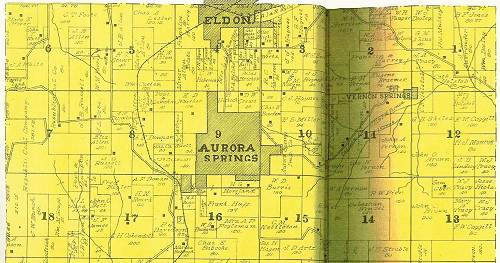
01 T41N R15W - Aurora Springs
Click image for larger view
The history of the town is well written on our own website:
Aurora Springs
In the mid 1800’s Aurora Springs was the largest town in Miller County and it was a booming resort area. It was listed as “The Great Sanitarium of the West” and was known as a renowned Health and Pleasure Resort of Missouri. It was incorporated as a village in 1881 receiving its popularity from the mineral springs that were discovered there. Improved land was selling at the rate of $10.00-$15.00 per acre which was a very prime rate at that time of Miller County history. It had a Congregational and a Baptist Church and shipped out grain, livestock and ore to other pars of the country. It had a newspaper, the Eldon Register that was published weekly; an Express company named Pacific, and a Telegraph office of the Western Union line. There was a stage coach daily to Jefferson City and the mail was also delivered daily. Its population was numbered at approximately 700 persons. The following are a few of its business places and their owners in this period of time: The Aurora Springs Mineral and Sanitarium owned by W.A. Miller; General stores were owned by John C. Driver, James S. Franklin, Robert S. Harvey, James M. Jobe, J. Kartz, William D. Wright and Hugh Logan; Hotels were owned by John M. Lutman (the Virginia House), Edward Anderson (The Aurora House), J.H. Moon and Noah Hoover; Saloons were owned by Joseph Anthony and John W. Fogelman. Other businessmen and their occupations included: Anderson and Taylor, livery stable; John K. Artz, grocery; J.T. Bills grocer; Andrew Bridges and Peter Siegel, blacksmiths and wagon masters; Andrew J. Cook, sawmill and flour mill; J.B. Cracker, carpenter; Reverend W.C. Downing, Baptist minister; Joseph Duncan, photographer; William C. Fritter, railroad agent and telegraph operator; James H. Hagen, livery stable; A.C. Harding, lawyer; Henderson and Company, shoe makers; Hunter and Swartwood, furniture makers; James Justice, carpenter; Alexander Klinger, jeweler and tiff miner; W.M. Lumpkin, lawyer; Green McClure, livestock buyer; Jasper McKinney, grocery; Alonzo Masterson, barber; the Miller Brothers (Herman L. and William A.) grocers, bakers, and confectioners; Reverend Robert Morrison, minister of the Presbyterian Church; J. Peterson and Company, lumber company; William Radley, shoemaker; George W. Shelton, physician; Frank C. Smith, sign painter; James A. Stevens, physician and postmaster; Mrs. J. A. Stevens, milliner; John H. Stover, lawyer and coal miner; Stover and Mansell, real estate; John T. Sullens, blacksmith; James M. Williams, tinsmith.
Aurora Springs boasted of fantastic hunting and fishing facilities; and Aurora Cave was described as unbelievable. It had a Gothic chamber, the Lovers’ Grotto, the Fountain of Youth, the Grand Fork, the Catholic Cathedral and the Death Chamber. Ample hotel accommodations were available at the fantastic price of only $3.50 to $8.00 per week with access to the curative springs nearby. It advertised that the Springs could cure “sore eyes, leprosy, tetter (any of various vesicular skin diseases such as ringworm, eczema, and herpes) kidney diseases, rheumatism, mild leg, neuralgia, paralysis, indigestion, female diseases, liver ailments…” and on and on…
Efforts were provided to improve the park, wall the spring and bore an artesian well a short distance from the spring. Fulkerson published its first newspaper, a half sheet, the Aurora Cresset in 1881.
However, the Missouri Pacific Railroad station was located about a half mile southwest of Aurora Springs and it was here the town of West Aurora sprang up. It was laid out by A.J. Armstrong in 1882. P.J. Davidson had the first store here and also operated a large tie contracting business. A hotel and blacksmith shop opened there. Stock, lumber and ties were the chief shipments from the West Aurora depot which by 1889 reported about $120 express and $550 freight receipts a month.
Two blows hurt the health resort’s boom. One was lengthy litigation after a former Kansas governor claimed he owned 40 acres in the park area. Aurora Springs won the final court decision, but the community progress had suffered in the meantime. The other was the location of the Rock Island Railroad line. It bypassed this village when the Jefferson City, Kansas City and Southwestern Railway Company (later called the Missouri Pacific) was built to the north through the small town of Eldon and eventually the town died away to the small village that exists today. Eldon eventually took over as the hub of north Miller County activity and grew into the county’s largest town as it remains today.
In addition to the fame of the springs at Aurora Springs the town also boasted of the Miller County Institute, a private educational facility (photo 02).
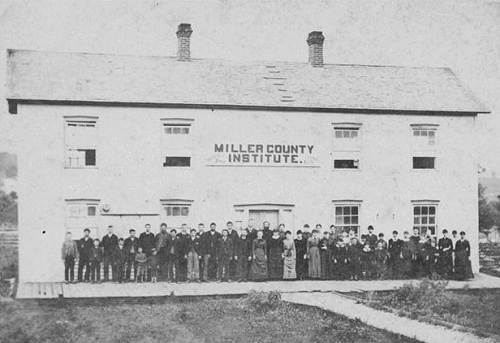
02 Miller County Institute
And a smaller public school was present for the citizen’s children (photo 03).
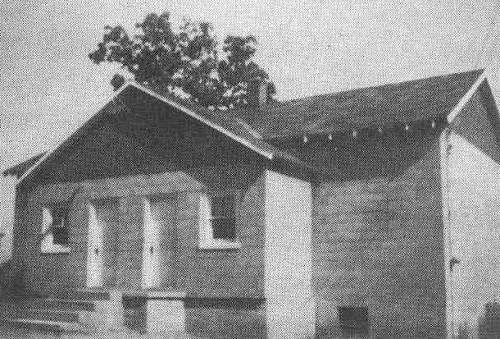
03 Aurora Springs School
Local historian, Dwight Weaver, also has written about Aurora Springs in his book, History & Geography of Lake of the Ozarks p.10:
Aurora Springs
History and Geography of Lake of the Ozarks Volume I
Dwight Weaver
P. 10
Aurora Springs, settled in the 1880’s, is located just inside the southeast edge of the Eldon, Missouri, city limits on Business Highway 54. In the late 1800’s and early 1900’s the two were separate towns. Aurora Springs was the largest town in Miller County in the 1890’s, with a population between 600 and 900, while Eldon had fewer that 400 people.
Business enterprises in Aurora Springs included several general merchandise stores, a blacksmith shop, telegraph office for western Union, several saloons, a sawmill, flourmill, tinsmith shop, barbershop, lumberyard, lawyers’ offices, and a newspaper office. There were also two churches, and the Aurora Springs Mineral Sanitarium owned by W. A. Miller.
In 1880, Reverend William C. Downing discovered the springs that issued from the hillside along the upper reaches of Saline Creek (most of these springs no longer flow). He believed they possessed strong medicinal qualities. A park was built encompassing the springs, and the town of Aurora Springs built up around the park. The sanitarium had four sources of water…Bluff Spring, Round Spring, Healing Spring and an artesian well. Promotions for what was billed as the “Great Sanitarium of the West” were going fine until a legal controversy erupted over the ownership of the parcel of land at the center of the park…a suit involving Governor George Anthony of Kansas, and the promoters of the sanitarium. For years it put a hold on the use of the springs which were the mainstay of the town’s economy. Anthony claimed he owned 40 acres in the park area. Aurora Springs finally won in court but too late to save the town.
In addition, the town lost its bid for the Missouri Pacific Railroad, which reached Eldon in 1903 and by passed Aurora Springs, giving birth to a site known as West Aurora (photo 04).
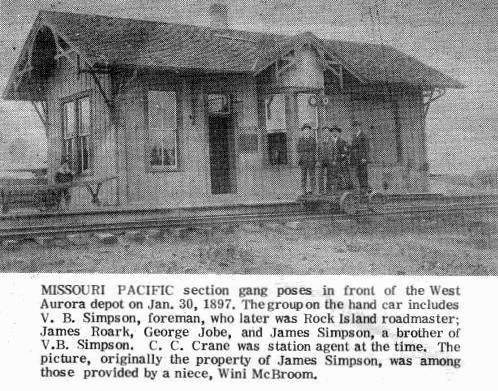
04 Missouri Pacific Train Station in Aurora Springs - Weaver
The final blow came on January 1, 1907, when the federal government’s Pure Food and Drug Act became effective. It dealt a death blow to patent medicine and mineral water promoters nation wide.
Aurora Springs did not go quietly. Over the years numerous efforts were made to revive interest in the springs, to no avail. The town’s merchants moved away and the town’s corporate status was dissolved in 1922. Eldon residential growth eventually overtook the old town site. Only a few hillside steps and concrete ruins remain in the now privately owned part to testify to the vanished dreams of Aurora Springs.
Here are some photos Dwight has collected of the old Aurora Springs as well as Klinger Cave (also known as Vernon Cave) and Lover’s Ford: (photos 05 - 10):
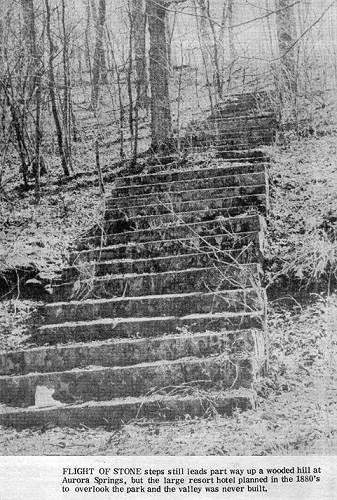
05 Aurora Springs - Steps to Hotel - Weaver
Click image for larger view
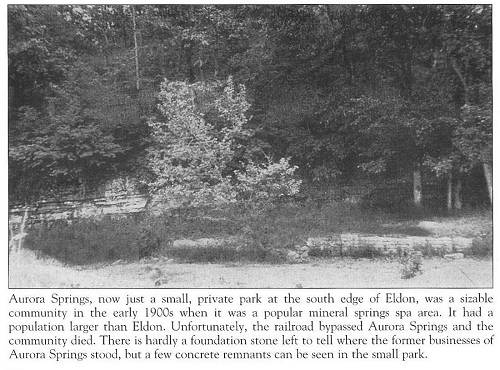
06 Aurora Springs - Weaver
Click image for larger view
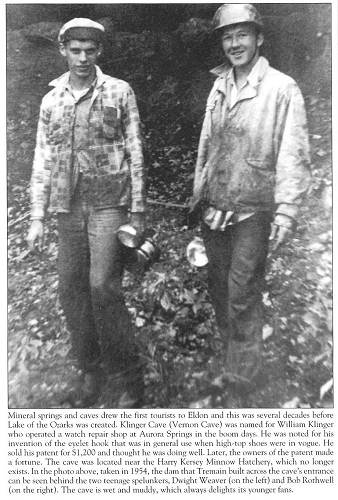
07 Klinger Cave - Weaver
Click image for larger view
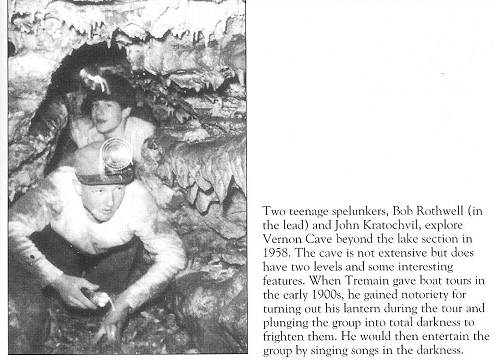
08 Klinger or Vernon Cave - Weaver
Click image for larger view
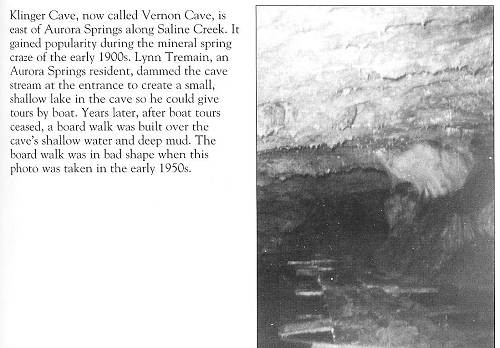
09 Klinger or Vernon Cave - Weaver
Click image for larger view
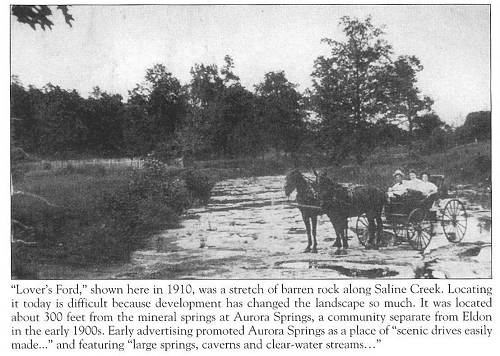
10 Lover's Ford - Weaver
Click image for larger view
Recently, I and museum volunteer Debbie Simmons Leonard, visited Floyd “Red” Norman of Aurora Springs to gather more information about the town (photo 11).
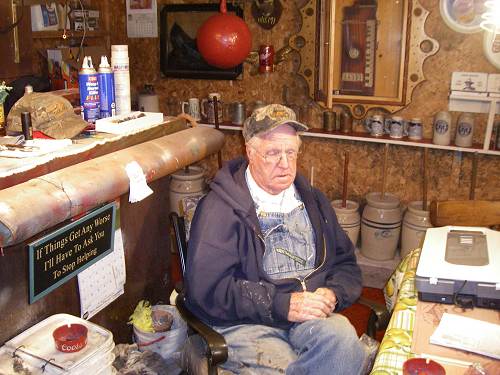
11 Floyd Norman
Floyd’s parents were Frank and Elsie Honaker Norman who lived in Henley. Frank was from St. Louis originally. After Frank died Elsie married Jewel Reed of Aurora Springs. Floyd was born in Henley but lived most of his life in Aurora Springs having been 8 years old when the family moved there. Floyd is well known in the area as being a building constructor, developer, dealer and trader. He lives in a home located at the top of a small hill in Aurora Springs where he has placed signs reading “Norman Hill.” He probably knows more about Aurora Springs than anyone around now. I had known him for some time as he had built the foundation for my mother’s home when she moved to Eldon.
Floyd has quite collection of historical materials. One of these is a very old book which was published in the early 1880’s by the original St. Louis business group which developed the Aurora Springs Sanitarium and Healing Springs. The book makes many claims about the healing powers of the Aurora Springs and was written so convincingly that it became one of the major incentives which drew not only tourists but many handicapped and chronically ill people to come to Aurora Springs for vacations and “healing.” The book also has some old engravings and artists’ drawings of some of the attractions at Aurora Springs:
PREFACE
Believing that the weak and afflicted need some lovely spot where a mild climate, pure air and efficacious waters can be had, we have published this guide, containing a few facts about a lovely place in the Ozarks.
To the tourists who seek a Resort, with the benefits to be derived from medicinal baths and mineral waters, we commend the following from the pen of the eminent tourist, Bayard Taylor:
“I have traveled all over the world to find in the heart of Missouri the most magnificent scenery human eye ever beheld.”
GUIDE TO
AURORA SPRINGS
OF CENTRAL MISSOURI (photo 12)
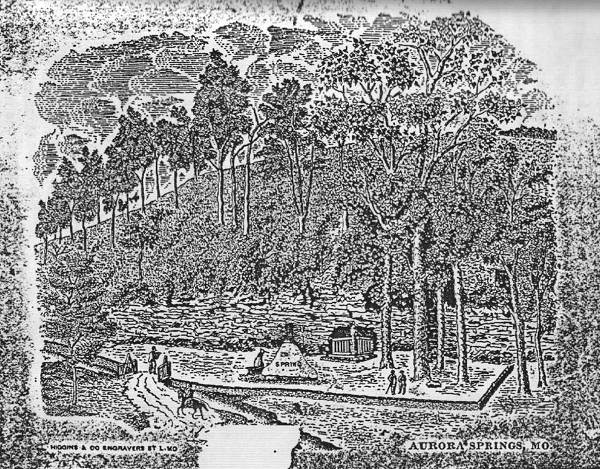
12 Engraving of Aurora Springs
GENERAL DESCRIPTION OF THE COUNTRY
The country may be described as a succession of narrow ravines, and well wooded, high, dividing ridges, running in a general east and west direction, with beautiful streams of clear water winding through and cutting the ridges at right angles, forming narrow gorges, which have coursing down their sides sparkling rivulets and saucy brooks, fed by springs located on the hill sides that let themselves down to the valley below by a succession of small cascades, that are lovely in their quiet picturesqueness, without snowy peaks, yawning precipices or rocky cannons. These ridges or mountains are carved through their entire length by water sources, and are serrated enough to lend a striking variety to the scenery, and charm the eye at every step.
TO THE PUBLIC
AURORA SPRINGS, MILLER COUNTY
To the Public:
The first case of Milk Leg that shall use water at these springs from six to ten weeks, under the direction of the subscribers, without a cure, the board bill will be made free through our chairman, Hon. John H. Stover.
J.M. WILLIAMS
WM. M. LUMPKIN
J. McKINNEY
A. JULKERSON
ALEX KLINGER
JOHN KEOWN
JAS. N. SCOTT
E.S. ANDERSON
For the convenience of parties living in St. Louis or elsewhere, desiring information about Aurora Springs, we herewith present in addition to the committee at the springs, the names of the following business firms and citizens of St. Louis, who will gladly furnish any information desired, viz:
J.B. Legg, of Legg Architectural Co., N.E. corner 5th and Olive Streets.
J.H. French, of Harris & French, Merchant Tailors, No. 703 Olive Street
H.J. Cantwell, of Cantwell & Edwards, Attorneys, N.E. corner of Broadway and Locust Streets
Peter A. Pickel, of Pickel Stone Company, No. 2845 Papin Street
J.H. Bethune, Railroad Contractor, S.W. corner of Broadway and Pine
Higgins & Co., Publishers, No. 313 Locust Street
W.W. Wagoner, Proprietor Monroe House, Jefferson City, Mo. (photo 13)
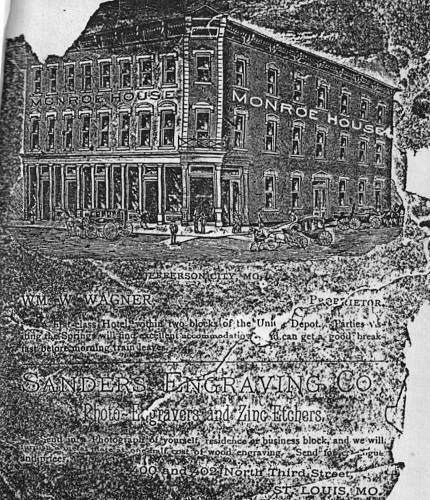
13 Monroe House - Jefferson City
Click image for larger view
A GUIDE BOOK TO
The invalid and pleasure seeker may find secluded spots for whiling away the sunny hours, where either the landscape or the high over hanging cliffs along the river banks will arrest their thoughts from business, and the grandeur and beauty of nature refresh their weary brain with scenes of nature’s loveliness.
That the Ozarks are rich in natural beauties and grandeur, no one will deny; and for those not having had the pleasure of visiting them, we quote the following from the pen of Bayard Taylor, the well known traveler, viz: “I have traveled all over the world to find in the heart of Missouri the most magnificent scenery human eye ever beheld.”
THE SPRINGS
These Medicinal Springs, on a spur of the Ozark Mountains, high above sea level, are centrally located in Missouri, about 35 miles south of Jefferson City, on the Missouri Pacific Railway. They are called the Round, Bluff, Healing, and Bath Springs. Besides these, there are several others which have their special champions and admirers, for different diseases, included in which is a Sulphur Spring, located about seven miles further down the Saline Creek. They are situated on the southern slope of the watershed, between the Missouri and Osage Rivers, and are justly noted for their healthy location, surrounded as they are by pure air, a salubrious climate, and the most perfect natural sanitary conditions.
AURORA SPRINGS, MISSOURI (photo 14)
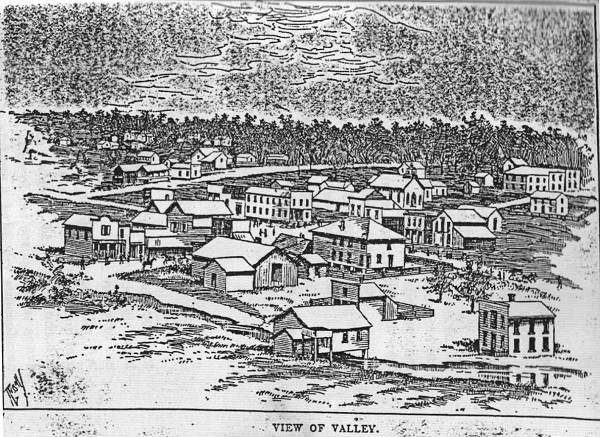
14 Aurora Springs Village
The curative qualities of the waters place these springs among the best in the world. Whether the wonderful cures that have been made by using these waters are the direct result of the medical properties of the waters, or on account of the waters and the perfect sanitary conditions is not known; neither is it a matter of any importance to the Invalid who finds health at this resort. It is sufficient to know that cases have been cured by drinking and bathing in these waters, for a few months, that had baffled for 20 years the skill of the most expert physicians, with all the medical waters, medicines and healing mediums that the chemists of the world have produced.
It seems little less that a miracle that invalids, after suffering for 20 years and becoming helpless, should be restored to perfect health at these Springs without the aid of medicine; but such are the facts, and the people are alive today, and if called upon or addressed will gladly attest to the cures. (See testimonials in back of book.)
EARLY HISTORY
From the close proximity of the Osage Indian Trail to these Springs, which was on the ridge immediately south, and from the arrow heads and spears found in the caves and under the ledges of rocks in the immediate vicinity, it would seem that the Indians were patrons of these waters at a time when the whole country was open to choice of locations; but the present occupancy dates from 1880, when the Rev. Wm. C. Downing found these Springs while hunting. He drank of them and found that they possessed strong medicinal qualities, and from his report of the toning up influences of these waters, many persons in the neighborhood tried their soothing virtues, and soon found that they were not only beneficial, but a positive cure for many diseases. The citizens were not unmindful of the demand that was likely to be made for future homes. They laid off a town and incorporated it. No sooner had this been done, and the people had begun to build homes and improve the town, than the title of the lands came into court; and at the filing of a suit by Ex Governor Anthony, of Kansas, for possession of the property, all improvements ceased, the people became alarmed and went to other localities, preferring to make a home where they could secure a good title. This suit continued in court until recently, and terminated in the establishment of the title by the Supreme Court of Missouri, giving the lands to the parties who laid off the town. During the years of litigation, many parties left and built up a business elsewhere; but today we have a flourishing town. There are several stores and the necessary hotel and boarding accommodations for invalids, also hot, cold and steam baths at reasonable prices. Recently, a St. Louis company has purchased lands adjoining the old town, on which they have several excellent springs. Aurora Springs, in addition to being a Railway Station, is a money order office, and is the largest town in the county.
FAMILY RESORT
No lovelier spot or quiet nook greets the stranger’s eye than this beautiful valley. The lovely drives along its high ridges or on the high rolling prairie, lend a charm for which the weary children or invalids highly prize. Along its primitive roads are lovely shaded nooks and clear, sparkling pools of water, with bright shining pebbles covering the bottoms, where the little ones can chase the bugs and minnows, or gather ferns and mosses along the paths, and pass the day in a joyous happy glee that cannot fail to build up and restore their little frames to rosy pink.
Children have come here helpless invalids, and went home in a few months healthy, sound in body and mind; some of the happiest children you ever saw. If you or the family need rest, or wish a quiet, inexpensive place to spend a few weeks or months, come to the Springs and discover a joyous, happy home, where you can spend the time with little ones in the open air in healthful sport. Especially is this true of the elevated portion of the range, and as these springs are located near a high dividing ridge, they have a dry, healthy atmosphere surrounding them, which together with the perfect natural system of drainage makes this one of the favored spots.
The country around the springs gradually slopes to the southeast, and is protected from the cold winter blasts from the north and west by higher ground, while the cool breezes of the summer come from the south and west down the great Osage River valley. Its many natural advantages and attractions make this resort a delightsome home for the invalid; no more healthful climate can be found than among these magnesium limestone rocks. Absolutely free from malarial influence, thee hills and ranges invite a friendly visit (photo 15).
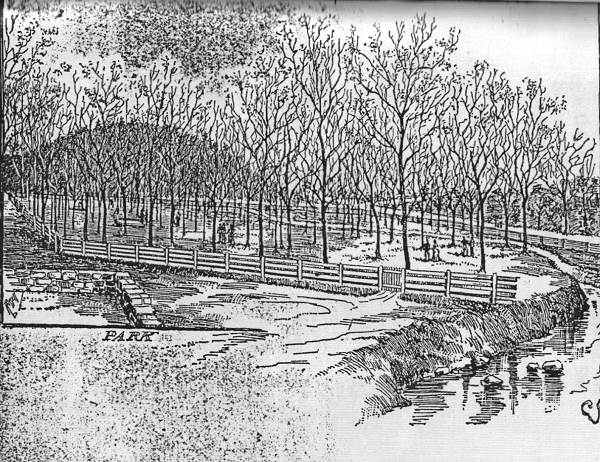
15 Aurora Springs Park
ELEVATION
The general elevation of the country is about 1000 feet above the level of the sea, and from some of the elevated points a grand view can be had of the Osage Valley to the south and wet, while the grand divide between the Arkansas and Missouri river valleys seems to tower up into the clouds in the far south; a more beautiful landscape is seldom seen. The location of the springs is far above the river bottom lands, and has a light, dry atmosphere; in fact, it is a beautiful, lovely county.
ANALYSIS
The following is the analysis of the Round Spring, by Professor Clifford B. Richardson, Analytical Chemist, Department of Agriculture, at Washington, D.C.:
Number of grains per U.S. standard gallon;
Ferrous Carbonate: 5.13 grains
Calcium Sulphate: 2.427 grains
Magnesium Chloride: 6.949 grains
Sodium Chloride: 4.009 grains
Lithia: 1.43 grains
Ferrous Oxide: .933 grains
Total grains per gallon: 20.878
In the Aurora waters the several forms of iron, lime, magnesia, and soda are so well blended in nature’s laboratory of mother earth that no chemist however skillful, he may be, can equal it. We honestly urge all invalids to give these waters a trial.
PARTIAL LIST OF DISEASES CURED
The waters are curative of Rheumatism, Cancer, Dyspepsia, Kidney Diseases, Chronic or Granulated Sore Eyes, Scrofula, Dropsy, Erysipelas, Paralysis, Piles, Milk Leg, and the various Female and Nervous diseases. They brace up the stomach, sharpen the appetite and induce sleep and rest.
NEW SPRINGS
Adjoining the town of Aurora Springs on the East, is a beautiful tract of land for building purposes, the part along the Saline Creek being level and of sufficient width for Park and Garden purposes, while the land on either side of the creek rises in a gradual slope, forming little knolls and lookout points by being cut through at right angles to the creek with small ravines, which afford not only a perfect system of drainage, but are lovely places for parks, public or private, having ample width for drives and walks to wind through them.
This tract has been purchased by a company composed mostly of St. Louisans, who contemplate in the near future the improvement of the property as a Family Resort and the building of a Hotel, the cut of which is on the opposite page (photo 16).
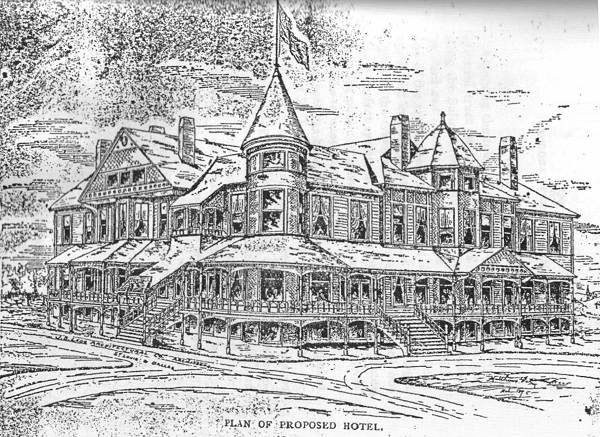
16 Aurora Springs Proposed Hotel
Along the foot of the knolls and hills, and in the ravines, are a number of springs of sparkling water. How many of them contain medicinal properties has not been determined, but the water of one of the main springs has been analyzed (qualitative), the result of which places it among the Medical Springs of Missouri.
ANALYSIS
Chlorine, Soda, Lime, Potassa, Alumina, Lithia, Iron, Carbonic Acid, Magnesia, Organic Matter
A RESORT FOR INVALIDS
These springs have no superior in their natural location, and their waters have proved a remedial agent for the afflicted that places them foremost in America as one of nature’s restorers. Not only can the invalid have the benefit of the waters, but of a delightful climate. Cool evening breezes during the summer weather, and the absence of the frisky mosquito, are sources of great relief to the weary invalid for a night’s sleep. Too much cannot be said in praise of these waters, for the cures they have performed, nor to induce those suffering from diseases that can be cured to come and try their efficacy.
One of the objects of the author is to herald the great benefits to be derived by suffering humanity from living at these springs. It is impossible to portray on paper the enthusiasm of the invalids, who, after suffering for years untold misery, and being reduced to helplessness, when they realized that they were not only relieved but permanently cured. Such feelings can be shared in only by the sufferers and their immediate friends; but the earnest, joyous life they now live can be attested by sending a letter to the addressed given in the following testimonials. If you are afflicted with any disease that is wasting away your vital energies, try these waters; you can be no worse than hundreds of others that have been benefited or cured by them. A wider range of diseases have been cured at these springs than the chemical analysis would seem to indicate but up to the present time the chemists have not been able to detect all the curative qualities and gasses contained in this great laboratory of Nature, and many cases that have for years been treated with the best and most expensive drugs formulated by the chemists, and with the most skilled physicians to administer them, have, after lingering along for years without any good result from medicines, been permanently cured at this resort by simply drinking and bathing in the waters. Had some chemist furnished the medicine instead of Nature’s Restorer, his services would command a fabulous price. No chemist has been able to analyze the waters and from it manufacture a water that will produce the same results.
RESORT FOR LADIES
By reference to another page, in this book, headed To the Public, can be seen an offer from the citizens. This shows the confidence that our citizens have in the efficacy of the waters in female troubles. See testimonials for the benefit derived at the change of life, where even after reason had been dehorned and they had been rendered helpless and insane, they have been permanently cured.
“Those who feel the heavy hand of time being placed upon them, and their looking glass revealing moth patches, etc., can by bathing in and drinking these waters so improve their complexion as to appear several years younger than their actual age. Young ladies, who by sickness or other causes have lost their youthful beauty, after the free use of these waters come out fresh as a rose. For the grand climacteric change of life, these waters are very beneficial and often prevent long and dangerous spells of sickness. This critical period of a woman’s life is pleasantly passed over by a short sojourn at the springs and a free use of these waters.
FAMILY RESORT
No lovelier spot or quiet nook greets the stranger’s gaze than this beautiful valley. The lovely drives along the high ridges or on the high rolling prairie, lend a charm that the weary children or invalids highly prize. Along the primitive roads are lovely shaded nooks and clear, sparkling pools of water, with bright shining pebbles covering the bottoms, where the little ones can chase the frogs and minnows, or gather ferns and mosses along the bands, and pass the day in a joyous happy glee that cannot fail to build up and restore their little frames to rosy health.
Children have come here helpless invalids, and went away in a few months healthy, sound in body and mind, and the happiest children you ever saw. If you or the family need rest, or wish a quiet , inexpensive place to spend a few weeks or months, come to the Springs and make a joyous, happy home, where you can spend the day with the little ones in the open air in healthful sport.
KLINGER’S CAVE OR THE ANCIENT GROTTO
(photo 17)
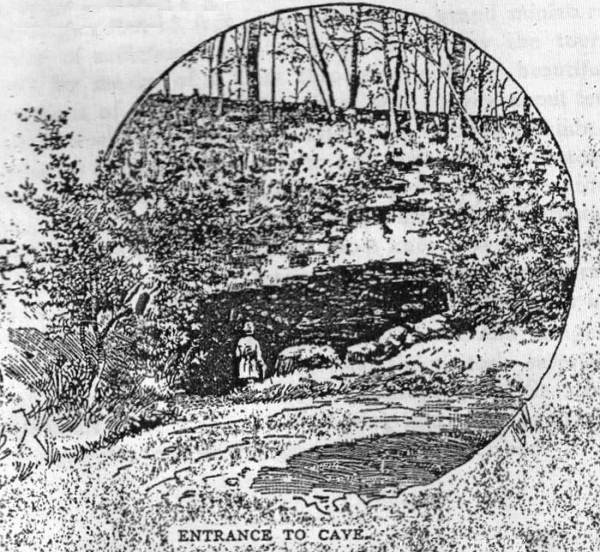
17 Klingers Cave - Ancient Grotto
This beautiful cave is situated on the right bank of the Saline Creek, one mile East of the Springs; on the southern slope of a thickly settled ridge. A picturesque road leads to it, along which the lofty oaks, silvery poplars and the elms with their long massive branches, shade the travelers on their pleasure trips to and from the cave, making it a most beautiful drive. The entrance of the cave is situated at an elevation of 100 feet above and 400 feet back from the creek. Passing through a beautiful miniature park, the visitor finds a large entrance or room, 30 X 50 feet, with a dark limestone ceiling 10 feet high. On the left of this mammoth room is a small ante room, with natural seats, and weird shaped rocks. At the lower entrance is a subterranean passage about 18 feet wide, which is a grand miniature lake of sufficient depth of water to convey the tourists by means of a boat through the more beautiful portions of the cave. This boat will convey about ten persons with convenience. They pass through a number of small rooms, which tends to call forth words of astonishment and delight from the passengers. At or near the end of this long natural hall, with its marbled and artistic walls, you are carried into the room known as the butcher’s shop, where, in clusters, hang beautiful stelliform stalactites. Other curious formations adorn the walls in profusion casting in the shade the draperies and designs of the Eastern Palaces of old, and the visitor’s surprise and admiration is best stated in the language of Senator McGinnis, of St. Louis, when visiting this resort, he says: “It’s grandeur can neither be written nor described.”
THE AURORA CAVE (photo 18)
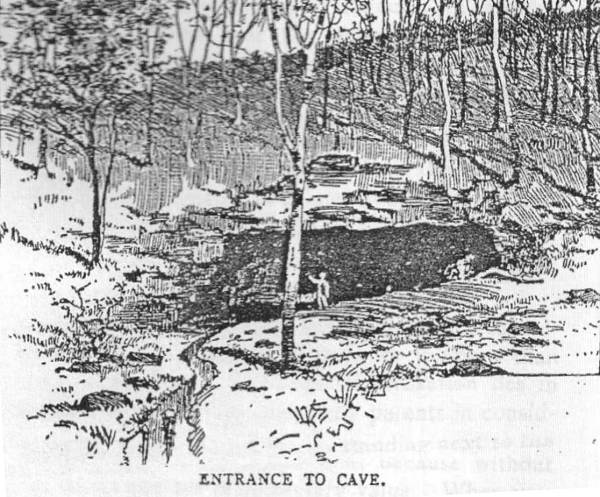
18 Aurora Cave
About two miles from the Springs is a great curiosity and noted place of resort for visitors to the Springs, a view of which is given on the accompanying page. This cave has never been thoroughly explored, and only a meager description can be given of its extent. The cave is reached from the Springs by a country road running within a few hundred yards of the entrance, which is on a hillside facing the South, about midway from bottom to top of the hill and is an opening about 25 by 60 feet. The chambers of the cave have a good width, and the cap rock overhead is probably from 30 to 60 feet. The floor of the cave for the first half mile, is a blackish loam covering the rocks; from there as far as explored it is clay and rock. In this cave hundreds of Indian implements, such as arrow heads, spear heads, bows, and arrows have been found and carried away by the pleasure seekers. In the cap rock overhead are many very pretty stalactites, although where they were within reach the prettiest have been broken off and carried away. About 400 yards from the entrance, at the first angle or turn in the passage, is a lovely dripping spring, the water of which is delightfully cool. It forms a small stream which threads its way through the chambers, out at the entrance, and thence down the hill side, which led to the discovery of the cave. The Indian implements are found near the entrance, on shelving rocks, while far to the rear in another chamber are to be seen a large number of bear pits, and their tracks are plainly visible. It was once my good luck to visit this cave with some bear hunters and witness their delight as they inspected one bear pit after another; the intense interest in which can best be understood by bear hunters.
Note: The authors here are referring to the cave which later was known as Stark Cave.
SCHOOLS (photo 19)
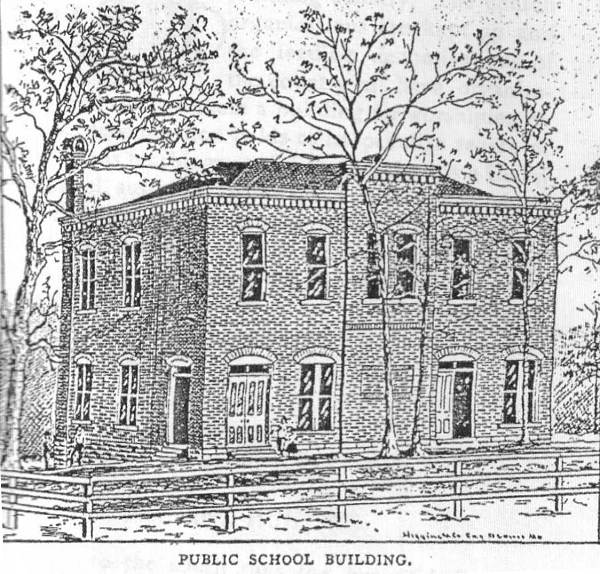
19 Aurora Springs Public School
There is no matter of greater importance to be considered when seeking a location in town or country than that of school facilities. The hope of civilization lies in the education of the young, and many parents in considering desirable points, regard this as standing next to the question of health. That comes first, because without health all things else are of secondary value. When you come to the springs bring your children and let them attend school…you will find the efficient. There is a Public School, with experienced teachers to give the necessary instruction, where all the modern improved methods of teaching are used to keep up an interest and advance the pupils to the highest standard. In addition to the Public School there are private schools and an Academy, where pupils can receive private instruction in higher branches of mathematics and the languages. The Academy was established by Professor H.L. Moles, in 1880. It now is conducted by Professor E.C. McIntyre. It is the aim to make the schools meet the requirements of a family resort where the children may receive especial attention.
CHURCHES (photo 20)
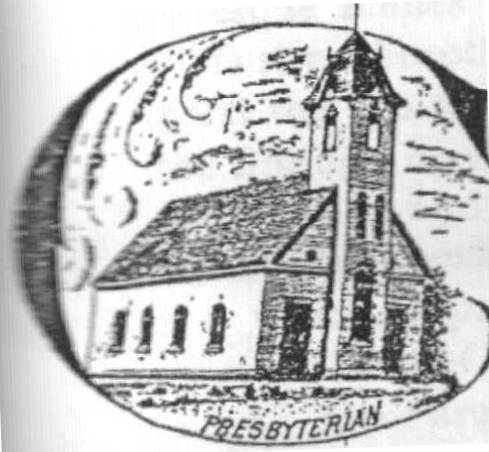
20 Presbyterian Church
Churches are well provided for, and sustained by the citizens of this village and the surrounding country. The church organizations are kept up and the leading denominations of the country all have organizations here, and some of them a building for worshiping in. While each denomination holds to its peculiar tenets of faith in religious teachings at the church, there is a Union Sunday School, sustained by all the denominations, where a broad Christian spirit is taught for the up building of morality justice and right; and parties visiting the springs will find a welcome for themselves and families, where the hand of fellowship is extended to all. The church forming the initial letter of this paragraph was the first church built at the springs.
FISHING AND HUNTING
A few miles to the south runs the beautiful Osage River, which is truly the fisherman’s paradise. Not only is the fishing good in the river, but all the small streams mouthing into it are filled with game fish of different species and the “Osage fishing grounds,” as they are known, has been a favorite fishing resort. Picturesque scenes and lovely nooks, where the limestone cliffs rise abruptly to a height of several hundred feet, greet the eye at almost every turn of the river. Life at the Springs may be either primitive, spent in camping out, hunting and fishing, or quietly and without excitement in the comfortable cottages. To the sportsman, this is a veritable park in the variety and character of the sport. Game of all kinds common to the Ozarks can be found. Deer are in abundance, also wild turkeys, quail, squirrels and rabbits while ducks are to be found in their season.
Testimonials
Invalid For Five Years
Mrs. D.J. Foley, of St. Louis, Mo. was an invalid for five years from kidney troubles and other ailments incident thereto. She suffered intense pain, and a portion of the time was confined to her bed. The disease and pain rendered her very thin and nervous, and she could get no relief from medicines, although administered by the most skilled physicians in St. Louis. No money was spared to obtain the best medical talent in the city, but she gradually grew worse until she commenced to drink Aurora Springs water. Within two weeks from the time she commenced to use the water she was greatly improved, and in three months she was cured. Today she is a strong healthy woman. Full particulars of the case can be had by calling on or addressing D.J. Foley, 3140 Hickory Street, St. Louis, Mo.
A YOUNG LADY OF ST. LOUIS
Miss Minnie Harre, of St. Louis, Mo., was taken sick at the age of 14 years. Two years later she became a helpless invalid, and for eight years was confined to her bed most of the time. During these long years of sickness and pain, she was examined and doctored by more than twenty physicians of this city, both American and German. The case seemed to be a puzzling one…one physician declaring it to be dropsy, another consumption, another cancer of the stomach, another tumor of the stomach, while still another (that eminent physician, the late Dr. Hodgen) pronounced it gall stone. With all that medical science could do, she still remained an invalid. On several occasions consultations were had on her case, and she had the benefit of the best medical talent in the city; but all were powerless to relieve her sufferings. Attention of the family was called to some very remarkable cures at Aurora Springs, and they resolved to take her there. She was carried aboard the Missouri Pacific train at St. Louis and taken to California, a station of that road; from there she was taken on a bed in a hack 15 miles to the springs. She commenced drinking and bathing in the waters, which in a short time made her deathly sick, and on three different occasions her mother thought her dying; but in a few days she began to improve, and in six weeks she carried the water to drink and bathe in, from the springs, five blocks to her boarding house. She then remained eight months at the springs; returned home for four months, when she again returned to the springs and remained eight months, making sixteen months in all at the springs. That she was permanently cured, I need but cite the fact that since then she has become the mother of two children. She is a healthy, robust woman, and may be found with her husband, J.K. Artz at the little grocery store, No. 223 Plum Street, where the history of her life can be obtained (photo 21).
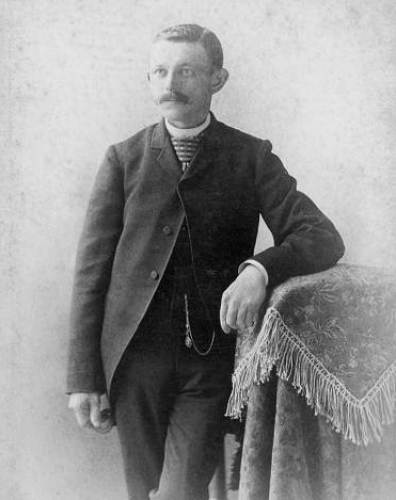
21 John Konrad Artz - 1878
Note: John K. Artz was an uncle of MCHS board member, Helen Schulte.
A SEVERE CASE OF MILK LEG CURED
Mrs. Martha Kemp, of California, Mo. had been afflicted for 35 years with a very bad case of Milk Leg. Her leg was not only greatly enlarged, but discolored, and pained her so that she was unable to walk. She drank the water and bathed her leg, applying cloths saturated with water. She had a severe attack of nausea. The next morning it was found by actual measurement that her leg had decreased by 1 ½ inches in size; on the second day all pain ceased, and in a few weeks she was cured, her leg resumed its natural size, and became strong and healthy.
Numerous cases of from 5 to 20 years’ standing have been cured at these springs, and as the waters have not in a single instance failed to effect a cure, the citizens make the offer “To the Public,” found on another page.
FEMALE DISABILITY AT CHANGE OF LIFE
Mrs. Louisa Miller was afflicted with mental derangement, about the change of life, and, after an examination by a number of physicians in consultation, she was pronounced incurable, and certified papers, preparatory to sending her to Fulton Insane Asylum were made out. Her sons, hearing of the effects of Aurora Springs water on nervous diseases, St. Vitus’ Dance and similar diseases, took her to the springs, and in two months she was cured. For particulars in this case, and similar cases, address her son, Herman Miller, Mayor of Aurora Springs, Mo.
Address Mrs. Martha E. Stoneman, Kearney, Kansas for a history of her own case, which was similar.
I doubt that such claims of cures recorded in the narrative above would be given such credence today as they were more than one hundred years ago; however, maybe they would be; it just depends upon the skill of the messenger and the trend today to seek “alternative medical treatment.”
I drove through Aurora Springs a few weeks ago and took the following photos of the Aurora Springs creek and the old park, now privately owned. The creek still runs with clear water over a rock base, typical of all our Ozark streams. No big spring is found today, although I’m sure multiple small springs exist along the course of the creek which keeps it running and clear (photos 22, 23 and 24).
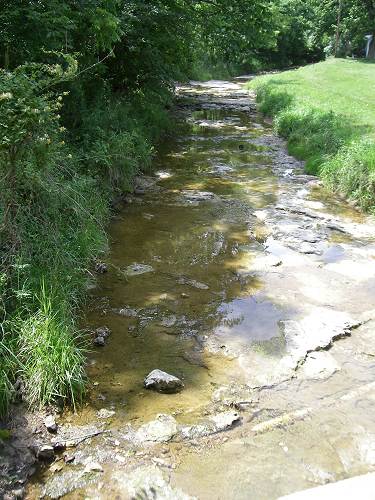
22 Aurora Springs Creek
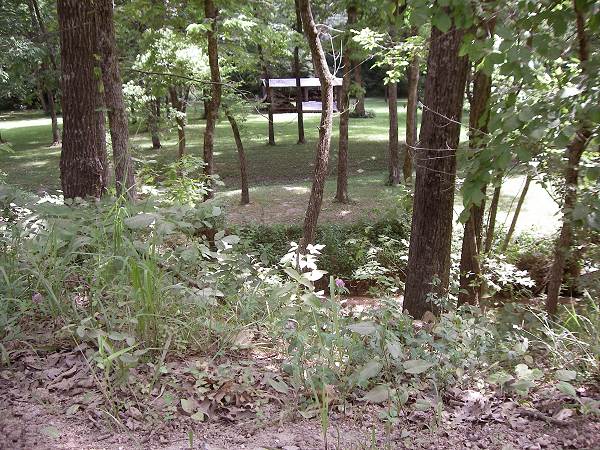
23 Aurora Springs Park
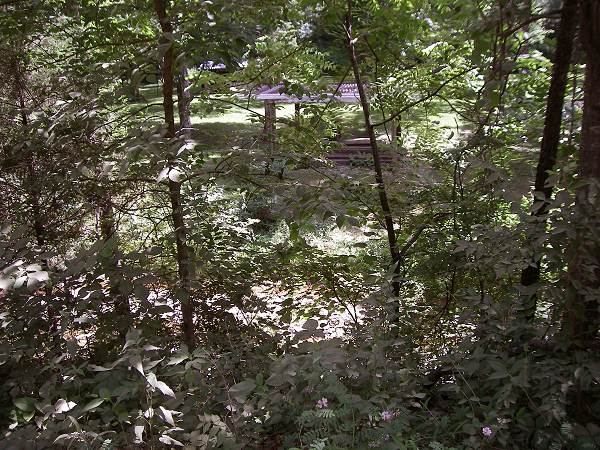
24 Aurora Springs Park
A friend of mine, Clifford Hill, who lived on a farm on the Tuscumbia Versailles Road in the valley below my home in Tuscumbia when we were younger told me this interesting story:
Sophie Wilson Hill, Clifford’s mother, was the granddaughter of a physician, Thomas Benton Wilson M.D. who came to Missouri from Indiana to practice medicine in Aurora Springs during the time it was considered to possess one of the world’s few healing springs. He built a new home there in 1882 which stood until twenty years ago when unfortunately it was destroyed by fire. Dr. Wilson moved to Kansas in the late 1800’s after the public’s fascination with Aurora Springs abated. His son, and Sophie’s father, Ralph Wilson, lived in several areas in Kansas and Oklahoma and Sophie herself lived the early part of her life in the “Indian Nation” of Oklahoma. She wrote an autobiographical book about her life including many interesting stories about her early days in Oklahoma, a copy of which is in our Miller County Museum library. Eventually, Ralph Wilson moved to a farm near Riley’s Bluff on the Osage River when Sophie was seven years of age. She attended Harmony School of the Flatwoods area which is where she met John Hill, Clifford’s father.
You can read more about Clifford, who is one of our area’s best fiddle players at this previous Progress Notes.
In the Progress Notes of April 4, 2011 I presented an Ameren Company (formerly Union Electric Company) DVD which featured several former employees of the company who helped build the Bagnell Dam. One of those of this group was John Barenbruch (photo 25).

25 John Barjenbruch
The video, however, did not mention that John, who was an engineer, had obtained some important historical photos of the building of the dam from an airplane. Recently, I found an old newspaper clipping (which did not indicate the source from which it was taken) which tells this interesting story about John’s work for U.E: back in 1929-1931:
Engineer Turned Cameraman
Aerial Photography Just a Fledgling in 1931
As the dam neared completion, Union Electric asked Tone and Webster to make an aerial photograph of the reservoir area including lands to be flooded and all land within one mile of the future lake shore.
John Barjenbruch, now retired and living at Camdenton, worked for Stone and Webster as a young engineer fresh out of the University of Illinois. He was asked to be the cameraman.
“Aerial photography was very new then, and we didn’t have a book on how to do it,” said Mr. Barjenbruch. The methods they employed, although seemingly primitive, had remarkable results.
Using the Union Electric Ford Tri Motor plane, the photography crew mounted the camera on two spirit levels through a hole cut in the cabin floor. Barjenbruch’s job was to watch the spirit levels on the device holding the model K-T Folmer Aero camera to make sure the camera was level when the photos were shot (photo 26).
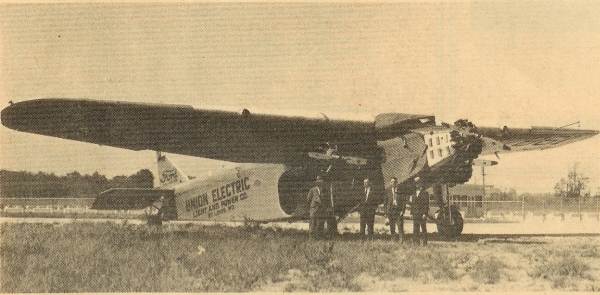
26 Ford Trimotor Airplane
While Barjenbruch shot the pictures, another employee timed the shots with a stopwatch. Because the plane made so much noise his voice could not be heard, he blew a whistle to signal Barjenbruch to take the next picture and handcrank the film through the camera to the next frame.
The camera filled the hole in the floor, and Barjenbruch says he never saw what he took a picture of…keeping the camera level was his most important task.
They made some 7,800 exposures on Eastman Pan Chromatic Aero Film No. 75, which gave a negative 7X9 inches. The edges of the pictures were distorted, and so, purposefully, they took overlapping views so that the centers of the pictures, when matched up, gave a few distortions.
The plane flew at 5,900 feet and was piloted by Union Electric employee Phil Love. “He was a good pilot, one of the best, and very safe,” says Barjenbruch. The plane ride, however, made most people airsick, and Barjenbruch says that his chief qualification for cameraman was that he didn’t get sick.
The landing field was just a graded bottom land pasture with a small asphalt patch at one end. Landing on it, according to another Stone and Webster employee “was wicked” because of the wind and rough field.
In addition to the pilot and the man with the whistle there was a relief pilot and a flight engineer who coordinated the plane’s path, altitude, speed and wind with the photographer’s readiness to shoot.
They photographed approximately 700 square miles in this manner, producing pictures which were on the scale of one inch equaling 500 feet. Later, on the ground, the prints were matched together. During preliminary field work the wooded hill land had been marked with lime at intervals with symbols of a square, Maltese cross, circle and triangle, 30 feet in outside diameter. Barjenbruch worked on that crew, too. These marks permitted almost perfect matching to give some 64 four foot square composite pictures showing the topography of the entire area.
Barjenbruch later worked for Union Electric Land and Development Company, moving from the lake area in 1938. Many times in his career he used aerial photography, particularly in transmission line surveys, but the Osage Project was his first and last job as a cameraman.
The same newspaper clipping also had an article about the depression era in which the Dam was constructed between 1929 and 1931. However, as the article recognizes, the area in the vicinity of the construction of Bagnell Dam escaped to some extent the deprivation other areas of the country suffered from the “Great Depression:”
Construction Spared Area From Great Depression
October 29, 1929, less that three months after Bagnell Dam construction began, the stock market crashed, and the United States entered into a great depression. But in central Missouri, the economy prospered because the dam was providing work for thousands of people. It was the only major construction project in the United States.
Union Electric had a mess hall that served over 800,000 meals during the construction period. Imagining the economic activity stimulated by this mess hall gives visions of economic prosperity for butchers, grocers, bakers, cooks, waitresses, etc.
People rented rooms in their homes and took in boarders. Every possible location that could be called a store front was pressed into service. Not only were the surrounding towns crowded, but new towns sprang up. Where before only a hillock or valley existed, now a settlement called “Dam Site” or “Spring Camp” or “Conner’s Camp” stood.
Pay rates were as low as 35 cents an hour, but five dollars worth of groceries “filled your car.”
As times were dire in other areas of the nation, people came to Bagnell hoping to get work, even when no hiring was taking place, as this quote from the Eldon Advertiser of June 19, 1930 reveals:
“C.A. Beeson, Chief of Police at Bagnell, rounded up 72 bums in his town in one day last week and shipped them over the Missouri Pacific. He said it became necessary to get the men out of town as there was no room for them and nearby farmers were complaining of losing the potatoes and garden.”
But the depression, which caused misery for these 72 “bums” and thousands of other people, did not harm the economy of central Missouri, because Union Electric was building Bagnell Dam on the Osage River.
Another interesting item from the news paper clipping was a table summarizing the dates of important events during the construction of the dam (photo 27).
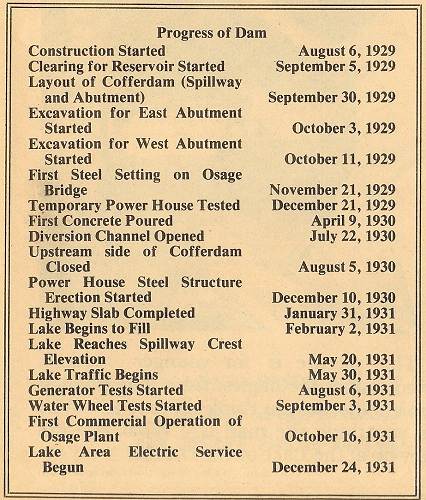
27 Dam Timeline of Events
Click image for larger view
This year is the sesquicentennial of our country’s Civil War which began in 1861. You can read more about the Civil War in Missouri and the events scheduled regarding the sesquicentennial by the State of Missouri at this website.
Miller County suffered in the Civil War and even for ten years or more afterward because it was a divided county, especially on the issue of slavery. Those settlers who came here from Pennsylvania and further north generally were fiercely antislavery. However, those from North Carolina and other southern states, many of whom had brought slaves with them to Miller County, were just as fervently opposed to the antislavery abolitionists. Before the war Miller County tax records recorded 250 slaves in the county according to historian Clyde Lee Jenkins. Of course, tensions over the issue peaked during and after the war causing feuds, raids and murders. Peggy Hake records in her writings that the Pennsylvanians were the most affected by the raids and bushwhacking which occurred often in the county against northern sympathizers. One besieged northern sympathizing family about whom Peggy wrote was that of Andrew Benage:
ANDREW L. BENAGE
(photos 28 and 29)
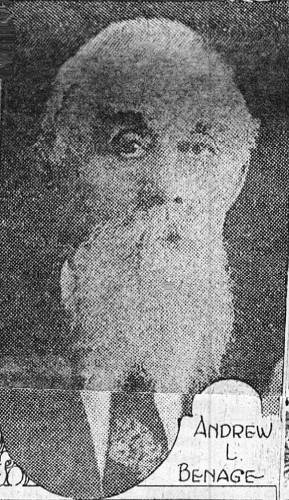
28 Andrew L. Benage
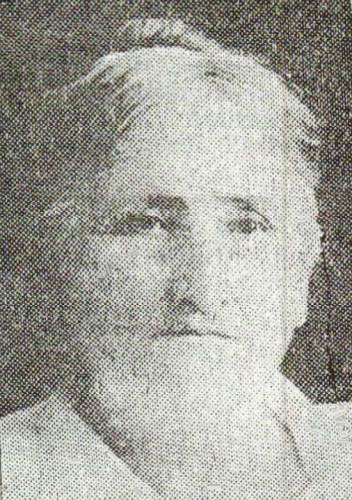
29 Mrs. Andrew Benage
Andrew L. Benage was born in Union County, Pennsylvania in February 1844. He was a son of John Benage and his first wife (name not found). John was also a native of Union County and was born there 3 August 1804. John and his first wife were parents of several children including: MARTHA A. BENAGE m. Charles Guger/Getgen (they later moved to Butler County, Iowa); MARY C. BENAGE 1834-1891 (never married); JOHN WALLS BENAGE 1839-1893 (never married); ANDREW L. BENAGE 1844-1932 m. Margaret J.______; REBECCA BENAGE 1845-1899 (never married); and MARGARET J. BENAGE 1848-1896 (never married).
Sometime before John Benage came to Miller County, which was prior to the Civil War, he married Elizabeth M. Irland, a widow with three daughters. They came to the Big Richwoods and settled near Iberia. In the 1860 census, John, Elizabeth, and his children were living together and her daughters (Cornelia and Mary) lived on the adjoining farm. Her children were: Cornelia Irland b. c/1840 m. Nicholas Long 1861; Mary L. Irland b. c/1845; and Martha/Mattie Irland. Martha/Mattie did not appear in the 1860 census so she may have married back in Pennsylvania and remained there.
Elizabeth Ireland-Benage acquired 420 acres of land when they came to the county. That land today includes the present site of the old Eads airport, Rekus Funeral Home, Assembly of God Church, First Baptist Church, Pendleton Acres, part of the Kleo Robertson land, and part of the James Burks property.
At the age of 45 years, in 1863, Elizabeth died and her land was passed on to her three daughters. Her will and probate information is on file in Miller County probate records. Her three daughters were named as her heirs (Cornelia Irland Long, Mary L. Irland, and Martha E. Irland). They were given all her land, her personal property and family heirlooms. Cornelia Irland, who married Nicholas Long in 1861, died in 1866 and left him with 3 small children to rear. The other two daughters, Mary and Martha, do not appear in the 1870 census, so I tend to believe they may have returned back to their home in Union County, Pennsylvania.
John Benage applied for a land grant in January 1859, which contained 40 acres. This land and other Benage land was situated about 2 miles south of Iberia. I believe some of the Benage descendants are living on this land today.
Andrew L. Benage and his older sister, Martha, were the only children of John Benage to marry. Andrew was able to pass the family name on to his six children and his sons carried the name on to later generations. In January, 1872, Andrew married a girl named Margaret. I have not been able to find a record of their marriage in Miller County, so they either married in another county or I overlooked it in my search. They became parents to the following: ERNEST E. BENAGE 1872-1949 m. Cora M. Mace in 1898; JOHN L. BENAGE b. 1874 m. Ethel G. Harrison; OTTO BENAGE b. 1876 m._______; FREDERICK BENAGE b. 1878 m. 1-Hester Bear 2-Nellie Muth; ALICE MAUDE BENAGE b. 1884 m. William Bear; and SYLVIA MAE BENAGE b. 1891 m. Dr. John O. Bradshaw.
All six children of Andrew and Cora (Mace) Benage were graduates of the Iberia Academy. Ernest graduated in 1894, the second student to graduate from the old school. In 1895, Fred, John, and Otto graduated together; Maude in 1904; and Sylvia in 1909. John and Otto Benage became doctors and practiced medicine in Laclede County, MO. Fred moved to Oklahoma and the two daughters, Maude (Bradshaw) and Sylvia (Bear) lived in southwest Missouri.
Andrew Benage was an influential businessman in the Iberia area for a number of years and then moved to Lebanon, Laclede Co., MO where he died on May 30, 1932 at the age of 88 years. He had served with the Union Army in the Civil War and remained active in the G.A.R. Posts at both Iberia and Lebanon. He died on Memorial Day in 1932 while his G.A.R. comrades were honoring departed soldiers at the Lebanon cemetery.
He was survived by his aged wife, Margaret, with whom he had celebrated 50 years of marriage in January 1932. He was also survived by four sons, and two daughters. Andrew's funeral services and his burial were held in Lebanon.
ADDENDUM TO THE BENAGE STORY:
The Benage family was among several Pennsylvanians who came to Miller County and settled in the Big Richwoods including the families of Tallman, Brown, Moore, Getgen, Noyes, Lahr, Groff, Heltzell, Irwin, Farnham, Hedges, Newhart, and Johnston. Some remained, some moved on.
During the Civil War, the Benages and other Pennyslyvanias, were threatened and harassed by the Confederate troops in the area. Being from a northern state and voting for Republican Abraham Lincoln in the 1860 elections, they were prime targets of the Confederate forces roaming in Miller County.
The southern sympathizers went to the farm of John Benage, south of Iberia, but John had already taken his family, some of his livestock, food supplies, and some equipment to a safe place and was gone for 2 months in hiding. While gone, he lost his corn crop and 15 acres of wheat, which was ready to be harvested. Later, in October 1861, the Confederates came back to his farm and the farm of his son, Andrew, and threatened the life of John and his family again. They destroyed the Benage's home furnishings, carried away kitchen equipment, clothing, cornmeal, breads, and meats that were preserved for the winter ahead. They stole his guns, powder, powder horns, and ammunition.......They took his horses, wagon, saddles, bridles, and the grain from his barn. Still not satisfied with the damage that had been done, they set fire to his hay and wheat stacks......Needless to say, the Benage family was left destitute but with their lives intact.
Getting through the Civil War times for these Pennsylvania families was a real heartache and quite a challenge, but they did survive and their descendants are still living in Miller County, over 140 years later..........
My mother’s family, George Bear and his descendents, were from Pennsylvania and they, just as the John Benage family, immigrated to Miller County and were supporters of the anti slavery-anti secession movement fighting for the North. George’s six sons all fought in the Civil War. You can read more about the Bears and their part in the Civil War at these two websites:
http://www.millercountymuseum.org/archives/110509.html
http://www.millercountymuseum.org/people/bio_b.html
The Bears and the Benages intermarried. As documented above by Peggy in her article above about the Benage family, two of Andrew Benage’s children married Bear descendents: Frederick Benage married Hester Bear, daughter of Andrew Bear; and Sylvia Mae Benage married William Bear, son of John Bear. John and Andrew Bear were brothers, sons of George Bear (photos 30, 31 and 32).
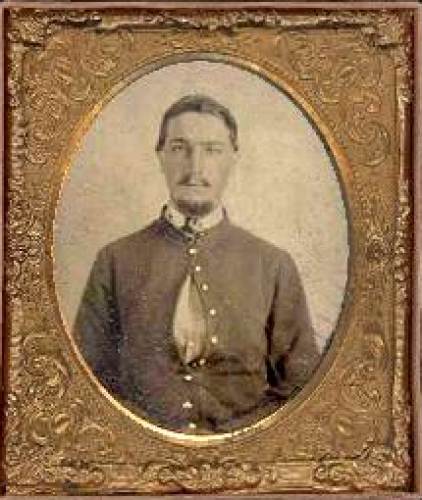
30 John Bear
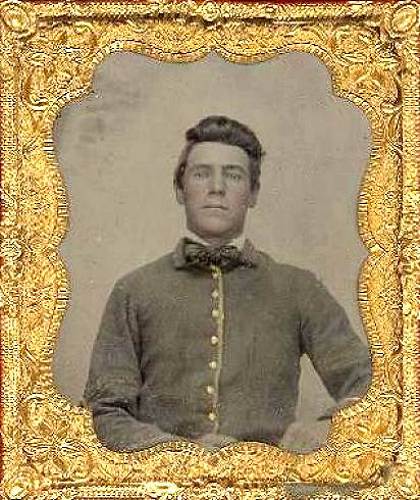
31 Andrew Bear
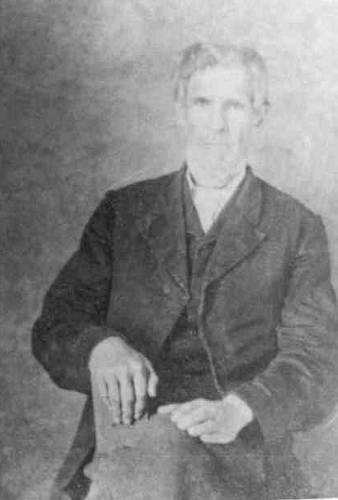
32 George Bear
William Bear was a son of John Bear (photo 33).
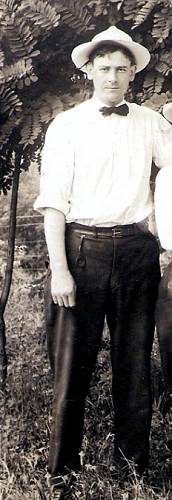
33 William Bear
Hester and Frederick were buried in the Bear Cemetery (photo 34).
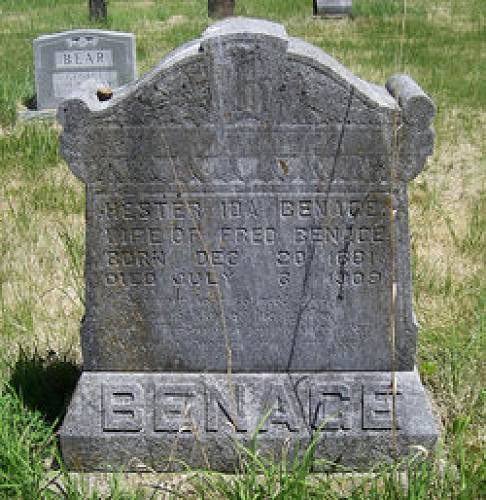
34 Fred and Hester Benage Tombstone at Bear Cemetery
More Miller County Benage history is found in this short narrative by Norma Benage, granddaughter of Andrew Benage, which was published in the Miller County History, June 17, 1983, page 10:
Tradition Found In France
By Norma Benage
The ‘Benage’ name is French. In France it was spelled ‘Basnage.’ The family moved from France about 1690 and went to Rotterdam, Holland.
John Bennage, my great grandfather, was born in Union County, Pennsylvania, near Lewisburg on April 17, 1804. He died on the farm near Iberia, Missouri, August 18, 1874.
My grandfather, Andrew Benage, was too young to join the Army. Two years later, when he was 18 years old, he served in the Missouri Militia. Later, on August 22, 1862, he enlisted in Company E, Forty Eighth Regiment, Missouri Volunteers, having the rank of Sergeant. He served until the end of the Civil War, being mustered out at Benton Barracks (photo 34a).
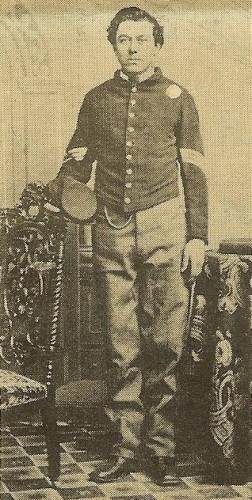
34a Andrew Benage in Uniform
Later, Andrew became a school teacher. While teaching in the Vienna School he met Miss Margaret Jane Rowden, daughter of Eccles and Kateryn Rowden of Vienna, Missouri. He was married to her on January 25, 1872. He engaged in Mercantile business in Iberia until he retired in 1905. The following quotation taken from a family history was written by Wilbur E. Benage, Lewisburg, Pennsylvania:
“They came on the ship ‘Adventurer,’ Robert Carson, Master, sailing from Rotterdam, Holland, and were qualified at Philadelphia” (that is, took the oath of allegiance to Great Britain).
Andrew and Margaret had six children: Ernest E. Benage, my father; John L. Benage and Otto C. Benage who became doctors; Maude (Benage) Bradshaw; Fred Benage and Sylvia (Benage) Bear.
Andrew died May 30, 1932 at Lebanon, Missouri.
Memorial Day brings many people to the area, some of whom regularly visit our museum. A couple of those visitors this year were Dennis Robinett and Joyce Holst Cochran (photo 35).
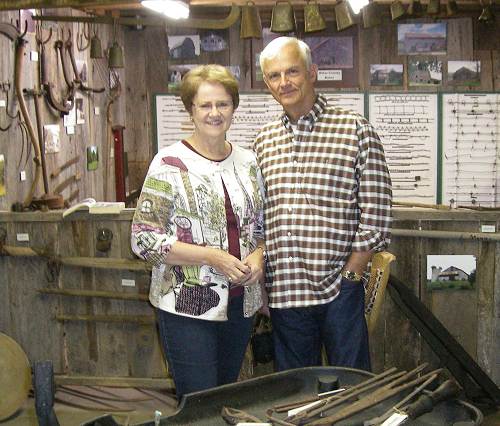
35 Joyce Cochran and Dennis Robinett
Joyce originally is from the Iberia area and Dennis, although raised in the Kansas City area, is related to the Miller County Robinett’s. He said Dennis his father was Lew Virgil Robinett, and his grandfather was Daniel McClellond Robinette, both of whom were native Miller County residents. Dennis sent me a photo of his grandfather’s tombstone from the Robinett Cemetery to prove that the spelling of his middle name is correct (photo 36).
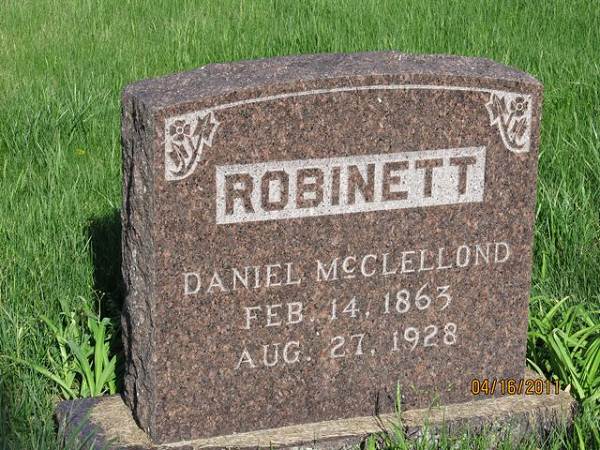
36 Daniel McClellond Robinette Tombstone
Karen Smith, one of our Miller County Historical Society board members, hosted a genealogical workshop Sunday afternoon, June 26, at the museum lower level conference room (photo 37).
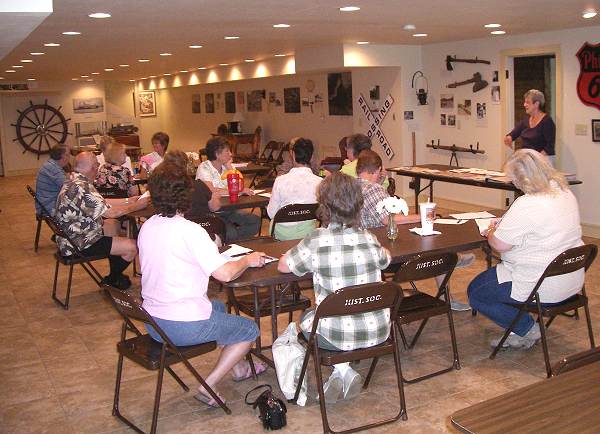
37 Karen Smith
Attendees participated from all areas of the county. Karen and museum director Nancy Thompson are our Society consultants for those of the public who consult the museum about genealogical questions. They are present at the museum every Monday for genealogical research and also are available for consultation by those who have questions regarding genealogical issues.
Note: The July 4 Progress Notes will be uploaded Saturday, July 2nd due to the Monday July 4th holiday.
That’s all for this week.
 Joe Pryor
Previous article links are in a dropdown menu at the top of all of the pages.
|

